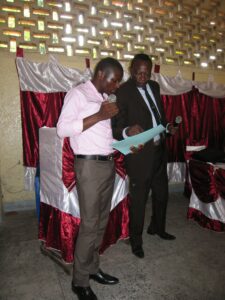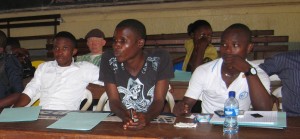Engaged Anthropology Grant: Joshua Walker

While a doctoral student at the University of Chicago, Joshua Walker received a Dissertation Fieldwork Grant in 2009 to aid research on “Crisis or Reconstruction? Street Children and Diamond Miners in Mbujimayi, Democratic Republic of Congo,” supervised by Dr. Jean Comaroff. In 2015 Dr. Walker received an Engaged Anthropology Grant to aid engaged activities on “Post-Extractive Futures: Living Without and Beyond Diamonds”.

Between October 21-23, 2015, Dr. Joshua Walker and Professor Emmanuel Kambaja Musampa of the University of the Witwatersrand (South Africa) and the University of Mbujimayi (Democratic Republic of Congo), respectively, co-organized a conference at the University of Mbujimayi. The conference theme was based on Dr. Walker’s Wenner-Gren funded doctoral dissertation research. It was entitled: “Post-Extractive Futures: Living Without and Beyond Diamonds in Mbujimayi.” This constituted an opportunity for local academics from a variety of disciplines (including anthropology, geography, geology, history, linguistics, and sociology) to meditate on the past, present, and future of the city of Mbujimayi in relation to the diamond industry.
The exchanges included both formal conference papers given by academics as well as an intervention by two former diggers, known as creuseurs in French. It was an occasion for academics, as well as university students and others, to reflect on the role and impact of diamond mining on the city and its environs. Mornings included formal academic papers and question and answer sessions; afternoons were largely devoted workshops where conference participants and attendees (most of whom were university students) reflected on different aspects of the morning’s theme.

Following the conference, the organizers produced a report (in French) that includes an introduction co-authored by Dr. Walker and Professor Kambaja; the conference abstract; the conference program; the written texts of the papers presented; and a conclusion written by Professor Kambaja. The latter includes a series of recommendations and reflections concerning the relationship between the diamond industry and the city. It proposes, among other things, the creation of a diamond museum; and the creation of a chair at the university in natural resource studies. It also notes some of the themes of the various papers: the need to diversify the local economy; the need to convert former mining sites into ecologically sustainable lands; and the need to promote other forms of income generation that have arisen since the decline of the artisanal and industrial diamond economies.
The report has been distributed to local academic institutions, government offices, and non-governmental organizations in Mbujimayi. It has also been made available online here. Finally, Professor Kambaja also did an interview in French and Cilubà concerning both Dr. Walker’s dissertation research as well as the theme of the conference and its outcome that was broadcast on multiple local radio stations over a period of several days.

In addition to this principal activity, two others were undertaken: Dr. Walker addressed a group of adult literacy learners and a church group in Cilubà on the questions surrounding the conference theme: namely, what have been the effects of the industrial and artisanal diamond mining industry on the city of Mbujimayi, and how citizens can begin to imagine and create a collective future outside and beyond diamonds.

Finally, Dr. Walker, along with Professor Kambaja and Professor Munyoka (one of the academics who presented at the conference) held two field workshops in mining villages near Mbujimayi: Kabwe and Bakwa Tshimuna. These two localities have both historically depended on artisanal diamond mining in the postcolonial period. Under the auspices of the Catholic church, we gathered small focus groups of 10 people in each place, with a mixture of men and women, young and old. The purpose of these workshops was to both inform members of communities surrounding the city about the ideas that had been presented at the conference, as well as to solicit their own reflections. The most important theme that arose in these conversations was that while a return to agriculture may be a way to mitigate the effects of the decline of the diamond economy, agriculture is no panacea. There is difficulty in finding arable land, for example. There is also the question of the scale at which agriculture can be conducted: a return to subsistence agriculture will not necessarily be useful in promoting a general reduction in poverty. Agriculture at a larger scale will require investment and coordination with the local and provincial authorities.